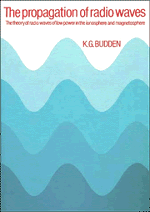 The Propagation of Radio Waves
The Propagation of Radio Waves Published online by Cambridge University Press: 06 December 2010
Introduction
This and the remaining chapters are mainly concerned with problems in which the approximations of ray theory cannot be made, so that a more detailed study of the solutions of the governing differential equations is needed. The solution of this type of problem is called a ‘full wave solution’. The subject has been studied almost entirely for plane stratified media. When the medium is not plane stratified, for example when the earth's curvature is allowed for, a possible method is to use an ‘earth flattening’ transformation that converts the equations into those for an equivalent plane stratified system; see §§ 10.4, 18.8. See Westcott (1968, 1969) and Sharaf (1969) for examples of solutions that do not use such a transformation.
This chapter is written entirely in terms of a horizontally stratified ionosphere and for frequencies greater than about 1 kHz, so that the effect of positive ions in the plasma may be neglected. The earth's curvature also is neglected.
The need for full wave solutions arises when the wavelength in the medium is large so that the electric permittivity changes appreciably within one wavelength and the medium cannot be treated as slowly varying (§§ 7.6, 7.10). Thus it arises particularly at very low frequencies, say 1 to 500 kHz. But even at higher frequencies the wavelength in the medium is large where the refractive index n is small, and some full wave solutions are therefore often needed for high frequencies too.
To save this book to your Kindle, first ensure [email protected] is added to your Approved Personal Document E-mail List under your Personal Document Settings on the Manage Your Content and Devices page of your Amazon account. Then enter the ‘name’ part of your Kindle email address below. Find out more about saving to your Kindle.
Note you can select to save to either the @free.kindle.com or @kindle.com variations. ‘@free.kindle.com’ emails are free but can only be saved to your device when it is connected to wi-fi. ‘@kindle.com’ emails can be delivered even when you are not connected to wi-fi, but note that service fees apply.
Find out more about the Kindle Personal Document Service.
To save content items to your account, please confirm that you agree to abide by our usage policies. If this is the first time you use this feature, you will be asked to authorise Cambridge Core to connect with your account. Find out more about saving content to Dropbox.
To save content items to your account, please confirm that you agree to abide by our usage policies. If this is the first time you use this feature, you will be asked to authorise Cambridge Core to connect with your account. Find out more about saving content to Google Drive.